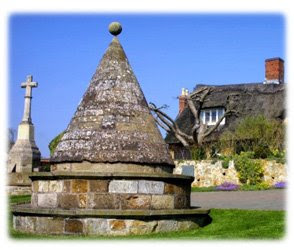
Aunque la tradición local sitúa la costumbre en tiempos muy remotos, lo cierto es que en el siglo XVIII era ya una costumbre arraigada.
Cuenta la leyenda que dos damas de Hallaton cruzaban un campo cuando fueron salvadas de un toro enfurecido por una liebre asustada que distrajo a la bestia. Para demostrar su gratitud a Dios por enviarles la liebre, donaron dinero a la iglesia con la condición de que cada Lunes de Pascua, el párroco donara a los pobres un pastel de liebre, doce panes de un penique y dos barriles de cerveza.
(Although local lore dates this custom in distant times, it is certain that it was already deep-rooted by the 18th century.
The tale goes that two ladies of Hallaton were crossing a field when they were saved from a raging bull by a startled hare, distracting the animal. To show their gratitude to God for sending the hare they donated money to the church on the on condition that every Easter Monday, the vicar would provide a hare pie, twelve penny loaves, and 2 barrels of beer for the poor of the village.)
La distribución de la comida y de la cerveza se convirtió en un asunto bastante escandaloso hasta el punto de que unos hombres del pueblo vecino, Medbourne, quitaron la cerveza e intentaron llevársela a su pueblo. Los hombres de Hallaton lucharon por su cerveza y su honor. Así nació la segunda parte de la tradición que perdura hasta nuestros días desde hace 200 años: Bottle-Kicking (pateando la botella).
(The distribution of the food and ale became quite a rowdy event, to such an extend that some men from the neighbouring village of Medbourne hijacked the beer and tried to take it to their village. The men of Hallaton fought for the beer and their honour. Thus the second part of the tradition was born which has remained up till now for 200 years: Bottle-Kicking.)
El acontecimiento empieza con un desfile por los pueblos de Hallaton y Mebourne llevando un enorme pastel de liebre (en realidad está hecho de carne de buey pues la veda de la liebre está abierta), y las tres "botellas", que en realidad son barriletes. Dos de ellos están llenos de cerveza y el tercero, llamado el "Dummy" (envase vacío o tonto), está hecho de madera y pintado de rojo y blanco.
El párroco bendice el pastel antes de cortarlo y lanzar los trozos a la gente para la "pelea".
Las "botellas" se llevan hasta la Buttercross (una estructura cónica coronada por una esfera, utilizada para guardar la mantequilla y el queso frescos en los días de mercado) para ser adornados con cintas. Aquí se distribuyen los panecillos.
(The event starts with a parade through the villages of Medbourne and Hallaton carrying a large hare pie (actually made of beef as there is close season for hare hunting) and the three "bottles", which are actually small kegs. Two of the bottles are filled with beer; the third, called "the dummy", is made of solid wood and painted red and white.
The pie is blessed by the Hallaton vicar before being cut apart and thrown to the crowd for the "scramble".
The bottles are then taken to the Buttercross (a conical structure with a sphere on top, used for keeping butter and cheese cool on market day) on the village green to be dressed with ribbons. Here, the penny loaves are distributed.)
No hay reglas para el bottle-kicking. Centenares de personas se reúnen en Hare Pie Hill (la colina del pastel de liebre) y se lanza al aire cada "botella" tres veces para señalar el comienzo de la competición.
Cada equipo (en el equipo de Hallaton, sólo vecinos del pueblo, sin embargo en el equipo de Medbourne puede apuntarse quien quiera) intenta llevar dos de las tres "botellas" al otro lado de cualquiera de los dos ríos distantes de 1,6 km que hay entre Hare Pie Hill y los dos pueblos.
(There are no rules to the bottle-kicking. Today at 3 o'clock, hundreds of people will gather at the top of Hare Pie Hill. Each bottle will be then tossed in the air three times, signaling the start of the competition. Each team (only locals in Hallaton team, but anyone can join Medbourne team), will try to move the bottles, on a best-of-three basis, across either of the two streams one mile (1.6 km) apart, between Hare Pie Hill and the two villages.)
El ganador se sube a la Buttercross y se bebe la cerveza del barril. Después todo el mundo lo celebra en los pubs... bebiendo más cerveza.
Como vemos un "deporte" muy poco PC (políticamente correcto).
Bueno...por otro lado, menos duro aunque igual de animado, está la carrera de huevos de Pascua en la Casa Blanca desde 1878, año en el que el presidente Rutherford B. Hayes abrió oficialmente los terrenos de la Casa Blanca a los niños para hacer carreras de huevos el Lunes de Pascua.
(On the other hand, less tough but equally lively, there's the White House Egg Rolling, since 1878 when President Rutherford B. Hayes officially opened the White House grounds to local children for egg rolling on Easter Monday.)
Este año el tema de la carrera es "¡Juguemos!", para animar a la juventud norteamericana a llevar una vida activa y saludable.
La Casa Blanca abrirá la parte sur a los niños de diez años y menores de esa edad, con sus familias, para disfrutar juegos, clases de cocina, actuaciones musicales en directo, cuentacuentos y la tradicional carrera de huevos de Pascua.
(This year’s White House Easter Egg Roll theme, ‘Let’s go play’, encourages America’s youth to lead healthy and active lives. The White House will open the South Lawn to children age ten and under, along with their families, to enjoy sports, cooking classes, live musical performances, storytelling and the traditional Easter egg roll.)
Y se acabaron las vacaciones de Semana Santa. Mañana, vuelta al colegio. ¡Alegría!
(Holy Week Holiday are over. tomorrow, back to school. Cheer up!)
Así que aquí va un clásico: School Days de Chuck Berry




















1 comentario :
Great music. Great musician. Great Chuck. Hail R&R.
Publicar un comentario